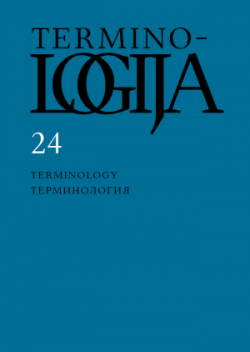Tarptautinių terminų apeliatyvacijos aspektai
Aspects of Appellativation of International Terms
Author(s): Jurgita MikelionienėSubject(s): Language studies, Language and Literature Studies, Applied Linguistics, Lexis, Semantics, Descriptive linguistics, Baltic Languages, Philology
Published by: Lietuvių Kalbos Institutas
Keywords: eponymous terms; appellativation of onyms; deonymized term; suffixal derivation of terms; semantic analysis of terms;
Summary/Abstract: Lithuanian terminology research into eponymous terms of various fields (anatomy,architecture, botany, etc.) began in the 21st century. However, a more systematic view that includes the general aspects of the appellativation of terms is still eligible, especially in order to introduce them to the future translators of the subject language, the editors, and other target groups that are interested in the applied and theoretical aspects of the scientific concepts. Although appellativation complements the terminology most often with the borrowed terms, and most eponymous terms were created back in the nineteenth century, it is an active and relevant way of creating new term names. For example, in January 2016 the discovery of four new chemical elements was announced, which, in line with the IUPAC recommendation to give chemical elements the names of mythological figures, minerals, locations, countries or scientists,in June 2016 were proposed to be named as nihon, moskov, tenesin and oganeson. The given terms were legalized on 28th November 2016.An onym loses its individuality in the process of turning into the appellative term,but acquires new features, and and the new words of various structures enter the language system. The article gives a brief overview of the 816 eponymic words from various fields created on the basis of a proper names selected from the Tarptautinių žodžiųžodynas (Dictionary of International Words) (2013), the structural and semantic varieties of the fully appellative terms, by combining linguistic and extralinguistic aspects related to the encyclopedic and scientific knowledge of various fields. According to the field,all the terms are divided into 15 groups (for example, chemistry, physics, mathematics and astronomy, botany, technical, clothing, sports, choreography, etc.). The main method of appellativation is metonymization when there is a strong logical connection between the proper name of a person or an area and a particular object or phenomenon.The oikonyms have become the background for more than 60 percent of the concepts researched, most of which have developed due to egocentric motives. Not only does the appellative onym acquire new semantic components, but it is often derivativelytransformed: among the deonymized terms there are not only grammatically adapted terms (fermis, klarkas), but also there is an abundance of suffixal derivatives(hesianas, mahometonybė, rusoizmas), compounds and blends (atlantozauras, orimulsija).
Journal: Terminologija
- Issue Year: 2017
- Issue No: 24
- Page Range: 127-144
- Page Count: 18
- Language: Lithuanian

